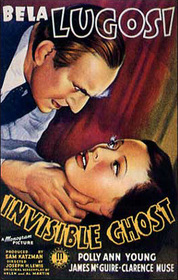Our editor-in-chief Nate Yapp is proud to have contributed to the new book Hidden Horror: A Celebration of 101 Underrated and Overlooked Fright Flicks, edited by Aaron Christensen. Another contributors include Anthony Timpone, B.J. Colangelo, Dave Alexander, Classic-Horror.com's own Robert C. Ring and John W. Bowen. Pick up a copy today from Amazon.com!
Invisible Ghost (1941)
Invisible Ghost's advertising material should put an asterisk after the title, one that leads to the following warning: "contains neither ghosts nor invisibility." The misleading title is aptly attached to a movie that drives the viewer around in repetitive circles. Without a restrained performance from star Bela Lugosi and a few atmospheric sequences by director Joseph H. Lewis, Invisible Ghost might be a complete waste of celluloid.
Charles Kessler (Bela Lugosi) has dinner with his wife every year on their anniversary. She ran out on him years ago, but that hasn't stopped tradition. There's still a plate in front of her empty chair and Charles still tries for small talk. Unknown to everyone, though, Mrs. Kessler lives close by in the spacious cellar of the garden house, addled and amnesic from a car accident. On those occasions when she does go outside, she likes standing outside whatever window Charles is nearest. When Charles catches sight of his long-absent wife, he goes off and kills somebody. This has happened at least once before the film even begins, but the police can't find a culprit because there are no fingerprints. There's also some nonsense with Kessler's daughter's fiancee and his twin brother that doesn't make a lick of difference to how everything turns out.
As you might guess from the synopsis, Invisible Ghost makes no sense. At least four people die in the Kessler household, yet the police never once suspect either Charles or his daughter Virginia (Polly Ann Young). Mrs. Kessler sneaks into the house on numerous occasions to feed herself and she's only caught when it's becomes convenient to the plot. We never get a satisfactory explanation for why Charles kills when he sees his wife. It might be supernatural; Charles seems to sense when Mrs. Kessler is outside the window and the madness lifts when she finally, inexplicably dies. Then again, she seems to be too dazed and bewildered to be actively controlling him with magic or hypnosis, and his actions indicate a psychotic break propelled by the appearance of his unfaithful wife. No matter from which angle you view it, nothing really adds up.
Invisible Ghost is the first in a series of nine films that Lugosi made between 1941 and 1944 for "poverty row" studio Monogram Pictures. After being relegated to second banana and red herring roles by Universal, his original "home studio", Lugosi's contract with Monogram allowed him be a star again, even if the budgets were low and the production values scant. They even gave him a few interesting acting opportunities, such as his role in Invisible Ghost. Bela's character is a pillar of the community with no plans for world domination, corruption of the innocent, or theft of personal property. Bela seems genuinely relaxed playing such a kind, decent person; we are given only a hint of his usual overdramatic hand flourishes and bizarre enunciation. Oddly enough, it's when Charles is in his killing trances that Bela's performance goes a bit stale -- he looks ridiculous staggering around, doing the zombie arm stretch.
Director Joseph H. Lewis's work in Invisible Ghost is a mixed bag. Some sequences are atmospheric and stylish, such as the first murder sequence, where we take the perspective of the victim, watching from her eyes as she dies. Others scenes, however, are dreary and static, with characters sitting around just talking (and talking inanities for the most part, since the dialogue is usually what propels the nonsensical plot). His sense of pacing is all over the map. The first half of the film zips along at an exciting clip, including a rapid-fire montage right before the midpoint. The second half, however, meanders -- an endless cycle of the investigation of the murders and Charles going crazy and committing a new murder which must also be investigated.
Still, Invisible Ghost does have its proponents. In his book Poverty Row Horrors, Tom Weaver conducts a survey of Lugosi historians and enthusiasts to rank Lugosi's nine Monogram horror films of the 1940s. Invisible Ghost came out at the top. Despite the poor quality of the production and the incomprehensible plot, Lugosi's surprisingly natural performance makes this "recommendation" not entirely unbelievable. Of course, it's also somewhat disturbing to contemplate that not only are the other eight films worse than this, but a few of them are likely much, much worse.








